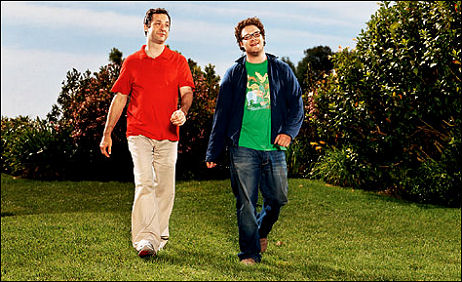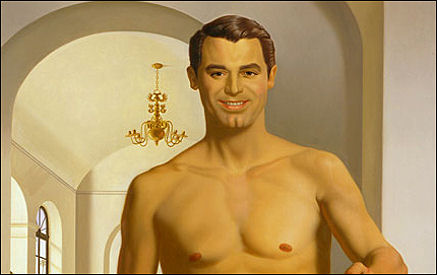A year or so ago I posted the following about Love, the quirky Netflix romcom series created by Judd Apatow, Lesley Arfin and Paul Rust, and starring Gillian Jacobs, Rust, and Claudia O’Doherty. A new 12-episode second season will debut on 3.10. My earlier riff was basically about the fact that even by the laws of the Apatow realm (i.e., guys who were too schlubby or dweeby-looking to be cast as hapless best friends in the ’80s or ’90s are now playing leads who get the girl), Rust is too Eddie Deezen-ish to land Jacobs as a girlfriend:
“The writing on Love is obviously first-rate (genuine, unforced, not too cute) and the acting seems fine…okay, pretty good. Everything seems right and harmonious except for one small element. In real life Paul Rust would be too dorky-looking to attract someone as hot as Gillian Jacobs. She looks like Kathryn Harrold, for God’s sake, and Harrold was a little too hot even for Albert Brooks in Modern Romance.
“Girls like Jacobs know what they have and the kind of guy they can land with a little luck and connivance. If Rust was lucky enough to pair up with Jacobs in real life it would be one of those odd relationships in which both parties realize that she’s doing him a huge favor. These always end sooner or later because the guy starts to feel diminished because he doesn’t feel he has any sense of equality; he feels like a waiter who’s been given an astonishing tip.
“These things also end because it’s always just a matter of time before she decides ‘okay, he’s cool and a good soul and not a bad lover, but that beak! Plus he’s neurotic and bothersome in about 17 or 18 different ways, and I know I could do better if I get out there and start sniffing around.’
I know whereof I speak. I lucked out with a beautiful neurotic blonde nearly four years ago [i.e., spring of 2013], and if truth be told…well, she wasn’t exactly doing me a favor but I did feel as if God had cut me a break. I knew from the get-go it was a limited thing and so did she, and I didn’t care because the benefits were kind of breathtaking.
“Rise of the Dreaded Twee-Males”, posted on 8.15.14:
Movies have been a thriving industry for a little over a century now, and for most of this period romantic male leads were cut from a certain cloth. There were two categories, of course — studly, straight-arrow romantic leads (everyone from Cary Grant to Van Johnson to William Holden to Steve McQueen to Ben Stiller to Brenton Thwaites) to less studly, mostly pleasing but less-than-drop-dead sexy romantic male also-rans or “best friends” (i.e., Ralph Bellamy back in the ’30s, Wendell Corey in the ’50s).
Romantic male leads used to be guys whom (a) women can pleasurably imagine going to bed with and/or marrying, and (b) straight guys recognize as superior alpha males with excellent genes. But not so much lately.
What’s changed is not only the quality of the alphas but the romantic also-rans — i.e., the guys who never got the girl. Over the last decade or so the rise of cheap digital cinema and…whatever, the Sundance Film Festival aesthetic plus downswirling GenY-ish attitudes plus a couple of Judd Apatow-perpetrated scenarios have ushered in a politically correct notion that dweeby, dorky-looking guys or less-than-drop-dead-knockout girls (i.e., Lena Dunham being the standard-bearer) are just as acceptable in a romantic context as anyone else.
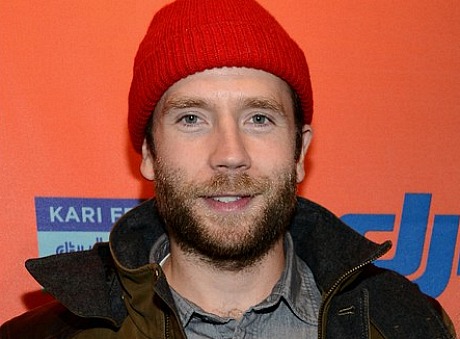
Twee-male Mark Webber (Laggies, Happy Crhistmas)
Put simply in a male context, guys who got the girl used to look like guys who got the girl…but no longer. Boiled down further, it’s become increasingly common these days for male romantic also-rans and even occasional romantic leads to fit the dreaded twee mold.
The rule of twee means that any homely or marginal or bearded, overfed, gross-looking guy or girl can hook up with good-looking types and nobody bats an eyelash. Blubbery Seth Rogen married to and boinking Rose Byrne every which way in Neighbors…if you say so. Mark Duplass making sensitive-guy moves on Melissa McCarthy in Tammy…really? Anne Hathaway being sufficiently taken with Rafe Spall to move in with him in One Day…remarkable.
In my mind nothing illustrates this all-but-certified attitude more than the fact that Mark Webber, by any measure a dorky, balding, narrow-shouldered, knit-cap-wearing, carrot-haired, sensitive-dweeb beardo type who wouldn’t have been allowed with 100 feet of any hot leading lady during the ’70s or ’80s or even the ’90s, was cast as a romantic-lead opposite Anna Kendrick in Joe Swanberg‘s Happy Christmas and then as Keira Knightley‘s earnest-but-clueless fiance in Laggies.
During Happy Christmas I couldn’t stop saying to myself, “Why does Kendrick find this guy remotely attractive or even acceptable as going-out-to-dinner-with material? What am I missing? If I was a girl or a gay guy I wouldn’t even look at Webber at a party.” During Laggies, one of the best girl-friendly romcoms I’ve seen in ages, I was muttering to myself, “Knightley is ambivalent about marrying Webber…okay, I get that…but how did she come to accept his proposal in the first place? He’s not even close to being in her league. This is the second vaguely off-putting relationship she’s been in lately after her relationship with the yukky Adam Levine in Begin Again. What’s her problem?”
Remember Rhys Ifans‘ character in Notting Hill (’99)? You know…Hugh Grant‘s creepy-spazzy neighbor? Ifans and Mark Webber are a lot more similar than dissimilar. Fifteen years ago Ifans was the perfect icky guy but in today’s twee realm he could almost be the romantic lead (or at least the appealing fall-back guy who treats the lady with kindness). This is how things are changing, what the twee aesthetic is doing to our culture.
If the twee-male scourge had manifested in the 1930s, Donald Meek, Allan Joslyn and Sterling Holloway would have gotten the girl.
Webber is an appealing, presumably well-liked guy and obviously a happening actor in the indie realm, as well as a director-writer of two indie-type films, Explicit Ills (a 2008 SXSW entry) and The End of Love (which played at Sundance in 2012). I’m sure Webber is cool to sit down with and I realize he’s married to the pulse-quickening Teresa Palmer, an Australian actress who is totally not twee-level. I’ve read they live in the Beachwood Canyon area with a son and I’m presuming….well, I hope things are fairly serene with the guy. I’m just saying that when I’m sitting in a plex with my small popcorn or watching a film on my Macbook Air, I do not want to see Webber fuck the girl in Act Three…please! I am not him unless I’m having a nightmare and he’s definitely not me.

Webber and wife Teresa Palmer.
“Eclipse of the Hunk”, posted on 3.12.08:
A very significant revolutionary concept has been pushed repeatedly in films produced, written or directed by movie-comedy maestro Judd Apatow over the last three or four years, and I’m not sure it’s been explained as throughly as it should be. The idea, admittedly old hat for anyone half-familiar with Apatow World, is that marginally unattractive guys — witty stoners, clever fatties, doughy-bodied dorks, thoughtful-sensitive dweebs and bearish oversize guys in their 20s and 30s — can be and in fact are the new “romantic leads” (for lack of a better or more appropriate term) in today’s comedies.
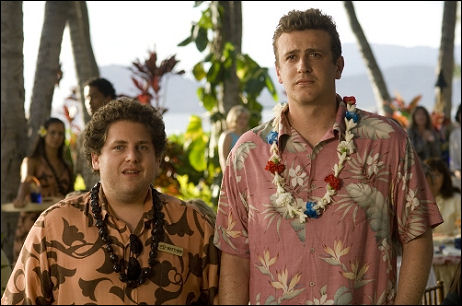
Jonah Hill, Jason Segel in Forgetting Sarah Marshall
Question is, what if this starts to manifest in realms outside Apatow World? Young teenage girls will always have a thing for the Zac Efrons and young Leonardo DiCaprios, but what if Hollywood, looking to follow Apatow’s lead in reflecting the real-life shlumpiness of typical GenX and GenY guys, generally starts to divest itself of conventionally good-looking actors as far as the over-21 ranks are concerned? Has Apatow started something, or does he live (and create) in a world totally his own?
I got started on this after watching Forgetting Sarah Marshall (Universal, 4.18) last night. The star is the galumphy, heavy-bodied Jason Segel, and the first thing you seem him do is wiggle his breasts in front of a bathroom mirror. Not by shaking his torso, but in the same way people wiggle their nose or their ears.
I immediately went, “Oh, shit…I’m stuck with this dude for the whole film.” Segel is an obviously bright guy with moderately appealing features, but he also has a chunky, blemished ass and little white man-boobs, and he could definitely use a little treadmill and stairmaster time and a serious cutback program regarding pasta, Frito scoop chips, Ben & Jerry’s and Fatburger takeout. I don’t relate to this shit at all, I was muttering to myself.
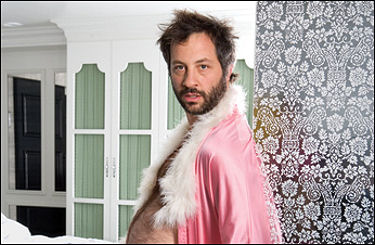
Judd Apatow
I’m not referring to the film itself (which everyone around me seemed to have a pretty good time with). I’m talking about the simple exercise of relating to a lead character during the first 10 or 15 minutes of a film and saying to myself, “Yeah, that’s me to some extent…I’m sorta like that guy…I’ve been there,” etc. If you can’t do that, as I couldn’t last night, the movie isn’t going to work for you. Like, at all.
The success of Apatow’s comedies strongly suggests that most moviegoers don’t have this problem. They’re cool with schlumps getting the girl. Dramas are another matter, but in Apatow World, at least, moderately good-looking (or at least pleasant-featured) regular guys, neurotics or semi-smoothies who go to the gym every once in a while and maybe resemble the slightly fuller-bodied, not-quite-as-good-looking brothers of Matt Damon or Adrien Brody or Brad Pitt are totally out.
Taking their place are guys who look like real guys, which means almost never slender or buffed, and frequently chunky, overweight or obese. And usually with roundish faces with half-hearted beard growth, hair on their backs, man-boobs with tit hairs, blemishes, and always horribly dressed — open-collared plaid dress shirts, low-thread-count T-shirts with lame-ass slogans or promotions on the chest, long shorts and sandals (or flip-flops), monkey feet, unpedicured toenails.
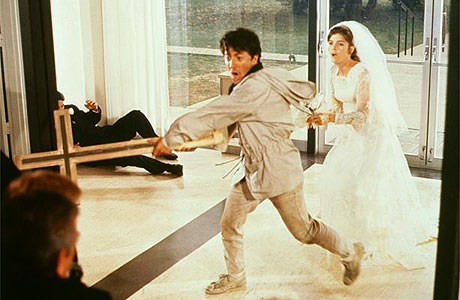
Dustin Hoffman, Katherine Ross in The Graduate
For better or worse, smart schlumps are the Cary Grants, Fred McMurrays, William Powells and Clark Gables in this very particular and restricted realm.
We’ve seen this phenomenon in six Apatow fims over the last four years — Anchorman: The Legend of Ron Burgundy (in which the semi-grotesque Will Ferrell seduces Christina Applegate), The 40 Year-Old Virgin (withdrawn, socially immobile Steve Carrell emerges from shell, falls in love with Catherine Keener), Knocked up (stoner-slacker Seth Rogen beds and gradually builds a serious relationship with Katherine Heigl), Superbad (the incorrigibly nerdy Christopher Mintz-Plasse gets lucky with a hottie, Jonah Hill finds the real thing with a nice girl in Act Three), Walk Hard (John C. Reilly-as-Johnny Cash, scoring and relationship-ing over a 40-year stretch with relative ease) and the upcoming Forgetting Sarah Marshall (Segel losing a hot-blonde girlfriend, hooking up with a beautiful brunette in the same class).
What’s happening here is more than just Apatow rewriting romantic movie mythology by selling variations of himself as sexually appealing. We’re talking about audiences totally buying into the notion that guys who look like this actually do attract hot women of good character, go to bed with them, fall in love and all the rest of it.
Ten years ago female moviegoers, I believe, would have totally rejected this. Twenty or thirty years ago mainstream audiences would have walked out of theatres in confusion (if not disgust) if guys who look like Rogen, Segel, Hill or Mintz-Plasse got the girl. If filmmakers had tried to push this concept in movies of the ’40s or ’50s the House Un-American Activites Committee would have held Congressional hearings. If films of this slant had been made in the 1920s or ’30s people would have seen them as tragedies or grotesque oddities in the vein of Todd Browning‘s Freaks.
When you think about it, the last time Hollywood said to the moviegoing public “hold on…guys who look like this can get the pretty girl and in fact do score in the real world” was 41 years ago, when the short, dweeby-Jewish Dustin Hoffman connected with Katherine Ross and bedded Anne Bancroft in The Graduate (’67).
Before that landmark Mike Nichols film male romantic leads had all been pretty much cut from the same three cloths — traditional standard-handsome smoothies a la Cary Grant or Rock Hudson or Clark Gable, good-looking troubled moodies like Marlon Brando, Montgomery Clift or Frank Sinatra, or all-American sunny-personality guys like James Stewart or Van Johnson. Hoffman’s Benjamin Braddock was something very new — nice-looking but anxious, neurotic, not tall and of the Hebrew persuasion.
I don’t know where else to take this idea or how to end the article, even, so I’ll just kneecap it here and leave well enough alone. I only know that if I were a girl or gay and Jason Segel came up to me at a bar and tried to put the moves on, I would scrunch my face up and say, “Are you fucking kidding me?”
